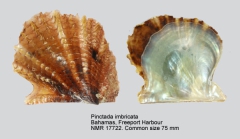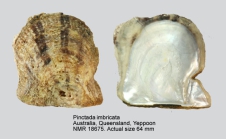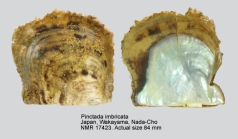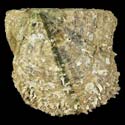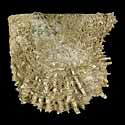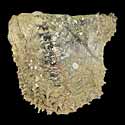WoRMS taxon details
Pinctada imbricata Röding, 1798
207901 (urn:lsid:marinespecies.org:taxname:207901)
accepted
Species
Avicula (Meleagrina) horrida Dunker, 1872 · unaccepted (synonym)
Avicula alaperdicis Reeve, 1857 · unaccepted (synonym)
Avicula flabellum Reeve, 1857 · unaccepted (synonym)
Avicula radiata var. canarina R. A. Philippi, 1849 · unaccepted > junior subjective synonym
Avicula squamulosa Lamarck, 1819 · unaccepted (synonym)
Meleagrina imbricata (Röding, 1798) · unaccepted
Pinctada imbricata imbricata Röding, 1798 · unaccepted
Pteria imbricata (Röding, 1798) · unaccepted
- Subspecies Pinctada imbricata fucata (A. Gould, 1850) accepted as Pinctada fucata (A. Gould, 1850)
- Subspecies Pinctada imbricata imbricata Röding, 1798 accepted as Pinctada imbricata Röding, 1798
- Subspecies Pinctada imbricata radiata (Leach, 1814) accepted as Pinctada radiata (Leach, 1814)
marine
Röding, P. F. (1798). Museum Boltenianum sive Catalogus cimeliorum e tribus regnis naturæ quæ olim collegerat Joa. Fried Bolten, M. D. p. d. per XL. annos proto physicus Hamburgensis. Pars secunda continens Conchylia sive Testacea univalvia, bivalvia & multivalvia. Trapp, Hamburg, viii + 199 pp., available online at https://www.biodiversitylibrary.org/page/16230659
page(s): 167; note: based in part on Knorr (1766), vol. 2, pl. 25 fig. 2-3, and on Chemnitz (1785), vol. 8, pl. 80 fig. 719 [details]
page(s): 167; note: based in part on Knorr (1766), vol. 2, pl. 25 fig. 2-3, and on Chemnitz (1785), vol. 8, pl. 80 fig. 719 [details]
Note Type locality not specified, but the text in...
From editor or global species database
Type locality Type locality not specified, but the text in Chemnitz (1785: 134) for pl. 80, fig. 719, cited by Röding (1798) reads (in translation) “According to the statement by Professor Müller in the text for Knorr’s work on shells, this genus is being found in the West Indies at the beach of the Antilles […]. I own several duplicates of this species, which however were collected from the shores of Tranquebar.” His figures are “ex Museo nostro”, so stem from Tranquebar/Indian material. Röding also referred to “4 St.” [= 4 Stücke = 4 specimens] in the Bolton collection. Current usage, following Abbott (1974) retains the name P. imbricata for Atlantic and Caribbean populations, and this would also be the valid name for worldwide populations if P. radiata (Leach, 1814) and P. fucata (Gould, 1850) were considered as synonyms (e.g. Huber, 2010) [details]
Taxonomy The papers by Tëmkin (2010) and Cunha et al. (2011) were published about simultaneously and do not discuss each other's...
Taxonomy The papers by Tëmkin (2010) and Cunha et al. (2011) were published about simultaneously and do not discuss each other's results. Tëmkin treated fucata and radiata as geographical subspecies of imbricata, whereas Cunha et al. presented a molecular tree that resolved them at the rank of species. This may be a result of the two papers using different markers: Tëmkin used 18S, 28S, 16S, and H3, whereas Cunha et al. used 18S and CO1. The matter is not fully resolved. [details]
MolluscaBase eds. (2024). MolluscaBase. Pinctada imbricata Röding, 1798. Accessed through: World Register of Marine Species at: https://www.marinespecies.org/aphia.php?p=taxdetails&id=207901 on 2024-04-28
Date
action
by
![]() The webpage text is licensed under a Creative Commons Attribution 4.0 License
The webpage text is licensed under a Creative Commons Attribution 4.0 License
original description
Röding, P. F. (1798). Museum Boltenianum sive Catalogus cimeliorum e tribus regnis naturæ quæ olim collegerat Joa. Fried Bolten, M. D. p. d. per XL. annos proto physicus Hamburgensis. Pars secunda continens Conchylia sive Testacea univalvia, bivalvia & multivalvia. Trapp, Hamburg, viii + 199 pp., available online at https://www.biodiversitylibrary.org/page/16230659
page(s): 167; note: based in part on Knorr (1766), vol. 2, pl. 25 fig. 2-3, and on Chemnitz (1785), vol. 8, pl. 80 fig. 719 [details]
original description (of Avicula alaperdicis Reeve, 1857) Reeve, L. A. (1857). Monograph of the genus <i>Avicula</i>. In: <i>Conchologia Iconica, or illustrations of the shells of molluscous animals</i>, vol. 8, pls 1-7 and unpaginated text. L. Reeve & Co., London. [stated dates: pls. 2-14, March 1857; pls. 1, 15-18, June 1857]. , available online at http://biodiversitylibrary.org/page/9127570
page(s): pl. 6, species 10 [details]
original description (of Avicula flabellum Reeve, 1857) Reeve, L. A. (1857). Monograph of the genus <i>Avicula</i>. In: <i>Conchologia Iconica, or illustrations of the shells of molluscous animals</i>, vol. 8, pls 1-7 and unpaginated text. L. Reeve & Co., London. [stated dates: pls. 2-14, March 1857; pls. 1, 15-18, June 1857]. , available online at http://biodiversitylibrary.org/page/9127570
page(s): pl. 5, species 7 [details]
original description (of Avicula squamulosa Lamarck, 1819) Lamarck [J.-B. M.] de. (1819). <i>Histoire naturelle des animaux sans vertèbres</i>. Tome 6(1): vi + 343 pp. Paris: published by the author. , available online at http://www.biodiversitylibrary.org/item/47441
page(s): 149 [details]
original description (of Avicula (Meleagrina) horrida Dunker, 1872) Dunker, W. (1872–1880). Die Gattung <i>Avicula</i> in Abbildungen nach der Natur mit Beschreibungen. pp. 1–84,. <em>in: H.C. Küster (ed.), Systematisches Conchylien–Cabinet von Martini und Chemnitz.</em> Volume 7, part 3. Bauer und Raspe, Nurnberg [pp. 1–56, pl. 1–18, 1872; pp. 57–68, pl. 19–24, 1879; pp. 69–84, pl. 25–27, 1880]., available online at https://www.biodiversitylibrary.org/page/34340065
page(s): 11, pl. 2, fig. 4 [details]
original description (of Avicula radiata var. canarina R. A. Philippi, 1849) Philippi, R. A. (1849-1851). Centuria quarta testaceorum novorum. <em>Zeitschrift für Malakozoologie.</em> 6(2): 27–32 [May 1849]; 6(3): 33-35 [July 1849]; 8(2): 29-32 [June 1851]; 8(3): 39-48 [July 1851]; 8(4): 49-64 [15 July 1851]; 8(5): 65-74 [July 1851]. [Second issue (July 1849) entitled in error]., available online at http://biodiversitylibrary.org/page/16300125
page(s): 22 [details]
context source (HKRMS) Leung KF. & Morton B. (2003). Effects of long-term anthropogenic perturbations on three subtidal epibenthic molluscan communities in Hong Kong. In: Morton B, editor. Proceedings of an International Workshop Reunion Conference, Hong Kong: Perspectives on Marine Environment Change in Hong Kong and Southern China, 1977-2001. Hong Kong University Press, Hong Kong. pp 655-717. [details]
context source (Bermuda) Jensen, R. H. (1997). A Checklist and Bibliography of the Marine Molluscs of Bermuda. Unp. , 547 pp [details]
additional source Steyn, D. G.; Lussi, M. (2005). Offshore Shells of Southern Africa: A pictorial guide to more than 750 Gastropods. Published by the authors. pp. i–vi, 1–289.
page(s): 204. [details]
additional source Masaoka, T.; Kobayashi, T. (2005). Species identification of Pinctada imbricata using intergenic spacer of nuclear ribosomal RNA genes and mitochondrial 16S ribosomal RNA gene regions. <em>Fisheries Science.</em> 71(4): 837-846., available online at https://doi.org/10.1111/j.1444-2906.2005.01035.x [details] Available for editors [request]
[request]
additional source Kilburn, R.N. & Rippey, E. (1982) Sea Shells of Southern Africa. Macmillan South Africa, Johannesburg, xi + 249 pp.
page(s): 161. [details]
additional source Cunha R.L., Blanc F., Bonhomme F. & Arnaud-Haond S. (2011) Evolutionary patterns in pearl oysters of the genus <i>Pinctada</i> (Bivalvia: Pteriidae). <i>Marine Biotechnology</i> 13: 181–192., available online at https://doi.org/10.1007/s10126-010-9278-y [details]
status source Tëmkin I. (2010) Molecular phylogeny of pearl oysters and their relatives (Mollusca, Bivalvia, Pterioidea). <i>BMC Evolutionary Biology</i> 10: 342., available online at http://www.biomedcentral.com/content/pdf/1471-2148-10-342.pdf [details]
original description (unavailable nomenclaturally) Chemnitz, J. H. (1780-1795). <i>Neues systematisches Conchylien Cabinet</i>. Gabriel Nicolaus Raspe, Nürnberg. Vol. 4 [1780]: [xxvii] + 344 pp. + 1 (errata), pl. 122-159; vol. 5 [1781]: [xxiv] + 324 p., pl. 160-193; vol. 6 [1782]: [xii] + 375 pp., pl. 1–36; vol. 7 [1784], [xii] + 356 pp., pl.. 37–69; vol. 8 [1785], xvi + 372 pp., pl. 70–102; vol. 9(1) [1786], xii + 151 pp., pl. 103–116; vol. 9(2) [1786], [xxvi] + 194 pp., pl. 117–136; vol. 10 [1788], [xx] + 376 pp., pl. 137–173; vol. 11 [1795], [xx] + 310 pp., pl. 174–213 [Work placed on the Official Index by ICZN Direction 1 (1954)] [volumes 1-3 are by F.H.W. Martini]. , available online at https://www.biodiversitylibrary.org/bibliography/43760
page(s): vol. 8 p. 134-135, pl. 80 fig. 719 [details]
page(s): 167; note: based in part on Knorr (1766), vol. 2, pl. 25 fig. 2-3, and on Chemnitz (1785), vol. 8, pl. 80 fig. 719 [details]
original description (of Avicula alaperdicis Reeve, 1857) Reeve, L. A. (1857). Monograph of the genus <i>Avicula</i>. In: <i>Conchologia Iconica, or illustrations of the shells of molluscous animals</i>, vol. 8, pls 1-7 and unpaginated text. L. Reeve & Co., London. [stated dates: pls. 2-14, March 1857; pls. 1, 15-18, June 1857]. , available online at http://biodiversitylibrary.org/page/9127570
page(s): pl. 6, species 10 [details]
original description (of Avicula flabellum Reeve, 1857) Reeve, L. A. (1857). Monograph of the genus <i>Avicula</i>. In: <i>Conchologia Iconica, or illustrations of the shells of molluscous animals</i>, vol. 8, pls 1-7 and unpaginated text. L. Reeve & Co., London. [stated dates: pls. 2-14, March 1857; pls. 1, 15-18, June 1857]. , available online at http://biodiversitylibrary.org/page/9127570
page(s): pl. 5, species 7 [details]
original description (of Avicula squamulosa Lamarck, 1819) Lamarck [J.-B. M.] de. (1819). <i>Histoire naturelle des animaux sans vertèbres</i>. Tome 6(1): vi + 343 pp. Paris: published by the author. , available online at http://www.biodiversitylibrary.org/item/47441
page(s): 149 [details]
original description (of Avicula (Meleagrina) horrida Dunker, 1872) Dunker, W. (1872–1880). Die Gattung <i>Avicula</i> in Abbildungen nach der Natur mit Beschreibungen. pp. 1–84,. <em>in: H.C. Küster (ed.), Systematisches Conchylien–Cabinet von Martini und Chemnitz.</em> Volume 7, part 3. Bauer und Raspe, Nurnberg [pp. 1–56, pl. 1–18, 1872; pp. 57–68, pl. 19–24, 1879; pp. 69–84, pl. 25–27, 1880]., available online at https://www.biodiversitylibrary.org/page/34340065
page(s): 11, pl. 2, fig. 4 [details]
original description (of Avicula radiata var. canarina R. A. Philippi, 1849) Philippi, R. A. (1849-1851). Centuria quarta testaceorum novorum. <em>Zeitschrift für Malakozoologie.</em> 6(2): 27–32 [May 1849]; 6(3): 33-35 [July 1849]; 8(2): 29-32 [June 1851]; 8(3): 39-48 [July 1851]; 8(4): 49-64 [15 July 1851]; 8(5): 65-74 [July 1851]. [Second issue (July 1849) entitled in error]., available online at http://biodiversitylibrary.org/page/16300125
page(s): 22 [details]
context source (HKRMS) Leung KF. & Morton B. (2003). Effects of long-term anthropogenic perturbations on three subtidal epibenthic molluscan communities in Hong Kong. In: Morton B, editor. Proceedings of an International Workshop Reunion Conference, Hong Kong: Perspectives on Marine Environment Change in Hong Kong and Southern China, 1977-2001. Hong Kong University Press, Hong Kong. pp 655-717. [details]
context source (Bermuda) Jensen, R. H. (1997). A Checklist and Bibliography of the Marine Molluscs of Bermuda. Unp. , 547 pp [details]
additional source Steyn, D. G.; Lussi, M. (2005). Offshore Shells of Southern Africa: A pictorial guide to more than 750 Gastropods. Published by the authors. pp. i–vi, 1–289.
page(s): 204. [details]
additional source Masaoka, T.; Kobayashi, T. (2005). Species identification of Pinctada imbricata using intergenic spacer of nuclear ribosomal RNA genes and mitochondrial 16S ribosomal RNA gene regions. <em>Fisheries Science.</em> 71(4): 837-846., available online at https://doi.org/10.1111/j.1444-2906.2005.01035.x [details] Available for editors
additional source Kilburn, R.N. & Rippey, E. (1982) Sea Shells of Southern Africa. Macmillan South Africa, Johannesburg, xi + 249 pp.
page(s): 161. [details]
additional source Cunha R.L., Blanc F., Bonhomme F. & Arnaud-Haond S. (2011) Evolutionary patterns in pearl oysters of the genus <i>Pinctada</i> (Bivalvia: Pteriidae). <i>Marine Biotechnology</i> 13: 181–192., available online at https://doi.org/10.1007/s10126-010-9278-y [details]
status source Tëmkin I. (2010) Molecular phylogeny of pearl oysters and their relatives (Mollusca, Bivalvia, Pterioidea). <i>BMC Evolutionary Biology</i> 10: 342., available online at http://www.biomedcentral.com/content/pdf/1471-2148-10-342.pdf [details]
original description (unavailable nomenclaturally) Chemnitz, J. H. (1780-1795). <i>Neues systematisches Conchylien Cabinet</i>. Gabriel Nicolaus Raspe, Nürnberg. Vol. 4 [1780]: [xxvii] + 344 pp. + 1 (errata), pl. 122-159; vol. 5 [1781]: [xxiv] + 324 p., pl. 160-193; vol. 6 [1782]: [xii] + 375 pp., pl. 1–36; vol. 7 [1784], [xii] + 356 pp., pl.. 37–69; vol. 8 [1785], xvi + 372 pp., pl. 70–102; vol. 9(1) [1786], xii + 151 pp., pl. 103–116; vol. 9(2) [1786], [xxvi] + 194 pp., pl. 117–136; vol. 10 [1788], [xx] + 376 pp., pl. 137–173; vol. 11 [1795], [xx] + 310 pp., pl. 174–213 [Work placed on the Official Index by ICZN Direction 1 (1954)] [volumes 1-3 are by F.H.W. Martini]. , available online at https://www.biodiversitylibrary.org/bibliography/43760
page(s): vol. 8 p. 134-135, pl. 80 fig. 719 [details]
 Present
Present  Present in aphia/obis/gbif/idigbio
Present in aphia/obis/gbif/idigbio  Inaccurate
Inaccurate  Introduced: alien
Introduced: alien  Containing type locality
Containing type locality
Syntype (of Avicula (Meleagrina) horrida Dunker, 1872) ZMB 101.673 [details]
From editor or global species database
Taxonomy The papers by Tëmkin (2010) and Cunha et al. (2011) were published about simultaneously and do not discuss each other's results. Tëmkin treated fucata and radiata as geographical subspecies of imbricata, whereas Cunha et al. presented a molecular tree that resolved them at the rank of species. This may be a result of the two papers using different markers: Tëmkin used 18S, 28S, 16S, and H3, whereas Cunha et al. used 18S and CO1. The matter is not fully resolved. [details]Type locality Type locality not specified, but the text in Chemnitz (1785: 134) for pl. 80, fig. 719, cited by Röding (1798) reads (in translation) “According to the statement by Professor Müller in the text for Knorr’s work on shells, this genus is being found in the West Indies at the beach of the Antilles […]. I own several duplicates of this species, which however were collected from the shores of Tranquebar.” His figures are “ex Museo nostro”, so stem from Tranquebar/Indian material. Röding also referred to “4 St.” [= 4 Stücke = 4 specimens] in the Bolton collection. Current usage, following Abbott (1974) retains the name P. imbricata for Atlantic and Caribbean populations, and this would also be the valid name for worldwide populations if P. radiata (Leach, 1814) and P. fucata (Gould, 1850) were considered as synonyms (e.g. Huber, 2010) [details]
| Language | Name | |
|---|---|---|
| English | pearl oysterAtlantic pearl-oyster | [details] |
| German | Atlantische Perlmuschel | [details] |
To Barcode of Life (11 barcodes)
To Biodiversity Heritage Library (1 publication) (from synonym Pteria imbricata (Röding, 1798))
To Biodiversity Heritage Library (15 publications)
To Biodiversity Heritage Library (28 publications) (from synonym Avicula squamulosa Lamarck, 1819)
To Biodiversity Heritage Library (4 publications) (from synonym Meleagrina imbricata (Röding, 1798))
To Conchology (Pinctada imbricata)
To Conchology (Pinctada imbricata)
To Conchology (Pinctada imbricata)
To European Nucleotide Archive (ENA)
To GenBank (10435 nucleotides; 120 proteins)
To PESI
To PESI (from synonym Avicula radiata var. canarina R. A. Philippi, 1849)
To USNM Invertebrate Zoology Mollusca Collection
To ITIS
To Biodiversity Heritage Library (1 publication) (from synonym Pteria imbricata (Röding, 1798))
To Biodiversity Heritage Library (15 publications)
To Biodiversity Heritage Library (28 publications) (from synonym Avicula squamulosa Lamarck, 1819)
To Biodiversity Heritage Library (4 publications) (from synonym Meleagrina imbricata (Röding, 1798))
To Conchology (Pinctada imbricata)
To Conchology (Pinctada imbricata)
To Conchology (Pinctada imbricata)
To European Nucleotide Archive (ENA)
To GenBank (10435 nucleotides; 120 proteins)
To PESI
To PESI (from synonym Avicula radiata var. canarina R. A. Philippi, 1849)
To USNM Invertebrate Zoology Mollusca Collection
To ITIS
